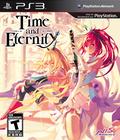NIS America does weird comedy. It's just its thing. From every Disgaea release to Gust's Atelier series of item-crafting-based RPGs to moderately well-known anime titles, NIS America has been a little different than most RPG developers. On the show floor at E3 2013, it showcased Image Epoch's newest RPG, Time and Eternity, which twists a few classic JRPG tropes in some interesting ways.
Time and Eternity casts the player in the role of a knight who's about to marry a princess — until assassins kill him. His wife-to-be reveals she has a second soul and with it, a distinct personality. Oh, and by the way, she can control time. She seals the knight in her tiny pet dragon and goes back to try and stop his murder. Everything goes all "Butterfly Effect," with the usual dose of humor as the kinda-sorta trio explores and tries to fix things.
While the game casts the viewpoint character as the knight/dragon, actual action has the player controlling Toki or Towa (the two souls of the Princess) as she travels and fights. Several elements make this a little different, and the graphical style bears mention. All characters are animated in 2-D and placed against 3-D backdrops. The animations are consistent in style and keep things very clear in combat. The animation style is reminiscent of many '90s anime, with a conspicuous but surprisingly ignorable difference between cast and backdrops. More importantly, it works with the game mechanics, especially in combat.
Combat is always one-on-one in Time and Eternity. Even if you face a group of monsters, you simply fight one and then turn to the next. Movement during combat is limited to approaching or backing away from enemies, and actions are performed in rhythm-focused real time. Aside from attacking, your character can and should block and parry attacks, and you can use elemental and time magic. Toki and Towa both ultimately learn the same spells but start from different points. While both can use a knife and a rifle, Toki shoots faster and Towa strikes faster.
Combat is also tweaked based on which character is in action. For example, bosses have completely different conversations dependent on which side of the princess is active. Unlike many games of this sort, switching characters is not trivial. There are rare items that let you make the jump, and you do so whenever the active character gains a level, but that's it. (The similarities keep this from being too painful of a jump in practice, fortunately.)
Other elements of the game include finding memory points and having regular conversations with the princess' friends. How you interact with them can affect the story in subtle ways. There are also plenty of things to find when exploring the backdrops, including the requisite treasure chests and lots of side-story bits that often feature animations to accentuate the game's humorous writing.
Time and Eternity has DLC plans but also is confirmed to have dual English and Japanese audio on-disc when it hits North America next month. So far, it looks like it will be a game to remember. Its animation-centric design plays quite well and meshes excellently with its sense of humor.
More articles about Time and Eternity











 Time and Eternity is a brand-new style of hand-drawn animation RPG where you witness your own death at your wedding before traveling back in time with your wife-to-be to track down your killer!
Time and Eternity is a brand-new style of hand-drawn animation RPG where you witness your own death at your wedding before traveling back in time with your wife-to-be to track down your killer!

























